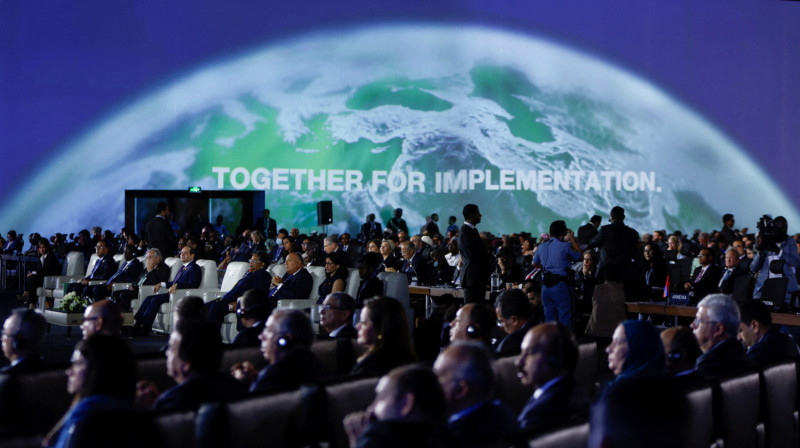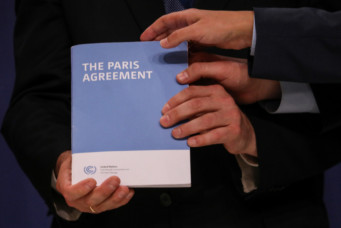Lessons from COP27: Between Progress and Challenges
While COP27 made progress in the areas of mitigation, adaptation, financing, and incorporating a gender, youth, and human rights perspective, Mexico is putting forward various initiatives to tackle remaining challenges

World leaders and delegates attend the COP27 climate summit in Sharm El- Sheikh, Egypt, Nov. 7, 2022. Mohammed Salem/Reuters
For decades, nations have debated, negotiated, and reached agreements through mutual understanding and compromise to build a seemingly universal narrative on the causes and effects of climate change. This narrative culminated with the Paris Agreement in 2015. We are currently entering another stage in which one of the greatest challenges of global climate governance is the construction of mechanisms that can be translated into concrete actions and that can enforce climate legislation at the international level.
The twenty-seventh Conference of the Parties (COP27) of the United Nations Framework Convention on Climate Change (UNFCCC) had special relevance due to the expectations it placed to implement climate change initiatives, and was consequently dubbed by media and participants alike as the “conference of implementation”.
Egyptian Foreign Minister and COP27 President-Designate Sameh Shoukry pointed out that this edition of the conference was considered decisive for climate action and therefore it was crucial to demonstrate a significant increase in ambitious commitments and expectations, as well as clear strategies. The proposed goals included immediately reducing and eliminating greenhouse gas (GHG) emissions in economic sectors to protect our planet from the increasingly negative impacts of climate change, and also deal with greater losses and damages.
Reviewed climate action plans provided alarming signs indicating that we are still far from reaching the Paris climate goal of holding the increase in the global average temperature to no more than 1.5 degrees Celsius above pre-industrial levels. One example of global shortcomings in climate change action given the current trajectory is that GHG emissions will have been reduced by 10 percent in 2030 compared to 2010, far short of the 45-percent reduction required in the 2015 Paris Agreement. This is taking into account all the Nationally Determined Contributions (NDCs) of the 193 Parties to the Paris Agreement, including new or updated contributions made between COP26 in Glasgow and up until two months before COP27.
The impacts of climate change that we are experiencing are palpable, but it is also clear that they are unequal and vary depending on the economic capacities of the regions and communities to combat them. The current economic system that favors competition must be transformed to put cooperation as a priority value to face the climate crisis. In this sense, financing is a central issue since it is clear that the poorest regions urgently require resources that developed nations can provide.
Decisions made to resolve the climate crisis require the broad participation of all social actors, placing the human rights approach at the center. Both issues, climate and human rights, continue to be matters in which various disagreements must be resolved through diplomatic channels. The fact that the decision-making process in Egypt was marred by an environment of geopolitical strife amid multifaceted crises should not be overlooked. One example is the economic crisis from the COVID-19 pandemic, which made it difficult for nations to allocate resources to climate issues. On the other hand, the energy and security crises caused by the Russia-Ukraine War produced a similar effect by placing geopolitical issues above environmental concerns. In this sense, it is fair to recognize and doubly value the diplomatic efforts of the Egyptian presidency during COP27.
With this context in mind, the three main objectives from the Mexican perspective—mitigation, adaptation, and financing—highlight what is in my opinion meaningful progress and at the same time emphasize the pending tasks and the lessons learned from negotiations at COP27.
Mitigation: The Sonora Plan
One of the main objectives which kickstarted COP27 was to recognize the urgency of accelerating climate action to achieve a substantial reduction in polluting gas emissions by 2030, in response to the urgent call contained in the February 2022 Sixth Assessment Report of the Intergovernmental Panel on Climate Change (IPCC). For this reason, a work program on mitigation was launched during COP27 in Sharm El-Sheikh in November to increase climate mitigation ambitions in all sectors.
During the conference, governments were also called on to review and strengthen the 2030 targets in their national climate plans, so as to accelerate efforts to phase out the use of energy from hydrocarbons and eliminate subsidies to inefficient fossil fuels. To this end, Mexico presented its clean water Sonora Plan, which could involve its North American partners, taking advantage of both the availability and potential for the generation of renewable energy and the great demand in the United States.
The plan includes several renewable energy developments that will satisfy the demand of various industries in Mexico and in the region. A clear example is the construction of Latin America’s largest solar energy plant in Puerto Peñasco, in the Mexican state of Sonora. Up to 5 gigawatts will be generated to supply the region.
Adaptation: A Global Goal to Reduce Vulnerabilities
The Paris Agreement established the global goal on adaptation. This global goal aims to enhance adaptive capacity, strengthen resilience, and reduce vulnerability to climate change and promote effective adaptation responses. At COP27, countries identified various priority elements that the global goal on adaptation should include for its effective implementation, such as: monitoring and verification, financial support, and definition of strategies that allow for cross-cutting implementation. This was done while taking into account the wide range of elements that make up climate change adaptation policies, such as the conservation of ecosystems, tangible and intangible cultural heritage, and their relationship with compliance with the 2030 Agenda for Sustainable Development.
The progress made at COP27 will also serve as the basis for the Paris Agreement’s first Global Stocktake, assessing its implementation, with the aim of improving the resilience of the most vulnerable. In this regard, there is a delay due to the lack of agreements on issues such as “collective adaptation” since the methodologies and metrics to evaluate this item are still being debated.
Moreover, new contributions of up to 230 million dollars were promised to the Adaptation Fund and it was also agreed that these resources should be allocated mainly to vulnerable countries. This result demonstrates progress in approaching financial matters with justice, which brings us closer to the establishment of concrete structures for climate action. The UN Climate Change Finance Standing Committee was also requested to prepare a report on doubling down on adaptation finance for consideration at COP28 in 2023.
Despite having the objective of establishing the mechanisms for financing adaptation, at COP27, the discussion still stalled at defining methodologies, instead of finding a common ground to move toward a more resilient world. Once again, the discussion on the access of developing countries to new and additional climate financing is made clear, as well as the historical responsibility of the main greenhouse gas emitters, developed countries, to provide them—if they want to meet the mitigation and adaptation objectives acquired in the Paris Agreement.
Financing: A Fund for Loss and Damage
A special mention is due regarding the efforts made on the financial arrangements for loss and damage associated with the adverse effects of climate change, especially with the creation of a new fund. In this sense, considering the importance of the economic and non-economic costs of losses and damages caused by climate change, mainly for those countries and regions that are in greater vulnerability, it has been essential to turn our attention to the repercussions of the climate crisis and repairing the damage, having a fundamental basis in the principle of climate justice.
During negotiations the most vulnerable countries expressed their concern regarding the increasing urgency of enhancing efforts to avert, minimize, and address loss and damage associated with the adverse effects of climate change. Considering that the global temperature has already increased 1.1 degrees Celsius above pre-industrial levels, this means that the vulnerability of already-vulnerable countries has gone up, putting the lives of people and the ecosystems of those countries at risk. In addition, the need to mobilize resources exclusively for loss and damage was underlined, since climate finance previously only focused on mitigation actions.
States have yet to decide on the amounts and the origin of resources provided to the fund, as well as the criteria for requesting such resources. The risk is that in future negotiations the momentum achieved on this issue will be lost and the final rules will not reflect the initial spirit of the initiative or its proponents. For this reason, the work in the framework of the “transition committee” will be key to making recommendations on how to implement the new financing agreements.
Climate Finance: The Need for New Objectives
The principle of “common but differentiated responsibilities” is based on historical evidence regarding the origin of the highest GHG emissions attributable to countries with higher incomes. For this reason, as an act of justice, in 2009 the richest countries made a significant pledge to jointly mobilize 100 billion dollars per year by 2020 to address the needs of developing countries.
Nevertheless, the promises have not been fulfilled. According to data from the Organisation for Economic Co-operation and Development (OECD), just 83.3 billion dollars was provided and mobilized by developed countries for climate action in developing countries in 2020 (13.1 billion dollars of which was mobilized private finance). In addition, 67 percent was focused on mitigation, and 24 percent on adaptation. The situation is even more worrying when we find that loans constituted up to 71 percent of climate finance in 2020, putting the most vulnerable countries further in debt instead of supporting them, while for every dollar pledged to address the climate crisis, four dollars are spent on fossil fuel subsidies.
Acknowledging that the richer countries have failed to mobilize 100 billion dollars per year by 2020, COP27 continued the discussion to set a New Collective Quantified Goal on Climate Finance that will be adopted in 2024. The goal must be consistent with Article 2 of the Paris Agreement and consider the needs and priorities of developing countries as well as consider the lessons learned from the previous objective. At COP27, countries also agreed to the Sharm El-Sheikh Implementation Plan. It stated that to achieve the global transformation toward a low carbon economy, investments of at least 4 to 6 trillion dollars per year would be required. However, raising that amount of funds will only be possible if a rapid and complete change of the financial system is achieved. Hence, the participation of governments, central banks, private banks, multilateral development banks, investors, and other financial actors such as investment funds and stock markets are essential.
However, greater participation of companies that contribute capital to combating climate change would necessitate adequate transparency mechanisms to prevent them from disguising highly polluting daily activities. That is why the construction of an institutional framework is essential: first, for the development of capacities on the application procedures and access to resources and, second, so that it can account for the destination and use of financing in a transparent manner before suffering from the paradox of the slow obtainment of resources against the vertiginous effects of climate change.
The results of COP27 on the matter are recognized as positive, since a need for balanced support was recognized to address the most relevant aspects of climate policies: adaptation, mitigation, and loss and damage. In addition, COP27 will serve as a reference and basis for future work in the construction of a new international climate finance scheme, including the New Collective Quantified Goal on Climate Finance, where new investors such as the private sector and financial institutions will take part. Moreover, guidelines and tools must be established for easy and transparent access to support, as well as to ensure that resources reach the most vulnerable communities.
More Progress is Needed: Taking Advantage of Human Rights, Gender, and Youth
The parties that have submitted new NDCs have reinforced their commitment to reduce or limit greenhouse gas emissions by 2025 and/or 2030, thus demonstrating greater ambition in climate change action. However, the number of countries that have implemented their NDCs is still limited and the aforementioned 45 percent reduction target is far from being fulfilled.
In the same way, greater involvement of relevant actors in each country to join the processes of defining and implementing projects aimed at increasing ambition in climate action, or in other words finding effective ways for financing, innovation, technology transfer, and capacity building, is pending. The lack of clear procedures for participation, particularly from the private sector, continues to lend itself to harmful practices such as greenwashing.
Mexico has promoted the incorporation of a transversal perspective of gender equality and human rights in all multilateral negotiation issues for effective climate action. Hence, the achievement of an improved version of the Lima Work Program on Gender and its Action Plan during COP25 should be valued as a positive precedent in the construction of multidimensional solutions.
References and inclusion are key to women’s autonomy, gender equality, and the fight against climate change. Examples include references to sexual and reproductive health; the need to eliminate multiple and intersecting forms of discrimination, gender-based violence, and harmful practices; just transition of the workforce; the enjoyment of a clean, healthy and sustainable environment; and the free, prior and informed consent of indigenous peoples, which is in line with the United Nations Declaration on the Rights of Indigenous Peoples.
Young people had a greater role in COP27 and played a vital role in decision-making and policymaking. The presence of the first pavilion for children and youth, as well as the first Youth-led Climate Forum, is a step forward for their involvement in decision-making beyond rhetoric.
Empowering people to take ownership of the environment and help protect it is essential. With this perspective, Mexico carried out the project “Operation COP: Youth Ambassadors for the Climate,” which allowed young people, including a representative of an indigenous people, to join the Mexican Delegation, lead negotiation sessions on priority issues, and be part of the decision-making processes.
Looking Forward to COP28
In the next negotiations, greater multisectoral participation should be promoted, as should an increase in the ambition and scope of adaptation and mitigation strategies in order to ensure our planet is more sustainable for all people.
In terms of financing, we must once again review the lessons learned from other initiatives that started with great momentum but that were later unable to scale up and raise the promised funds, along with facing a lack of transparency and the difficulty in implementing. It is important to avoid repeating this, as it undermines credibility between the parties, and also weakens the global public opinion that expects consistency in the commitments and actions of world leaders.
It is undeniable that 2023 will be a fundamental year for defining the processes, actors, and mechanisms necessary to meet the objectives of the Paris Agreement, and to achieve global climate action. We must continue with an approach that leads us to close the inequality gap and empower us collectively to face this great challenge that is climate change.




